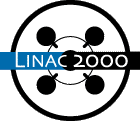
Y. Thiery, J. Gao, J. Le Duff (LAL)
A bunching system is proposed for CLIC/CTF3 which consists of two prebunchers and one travelling wave (TW) buncher with variable phase and group velocities. The electron beam is emitted from a 90KV DC gun and since the average macropulse beam current (4A) at the exit of the TW buncher is rather high, inside the TW buncher one has to take the beam loading effect into consideration. In the initial phase the frequencies of the two prebunchers and the TW buncher are all set to 3 GHz. For the final version of the bunching system the frequency of the first prebuncher will be 1.5 GHz instead of 3 GHz. By using PARMELA, it is shown numerically that with the foreseen frequencies (1.5 GHz and 3 GHz) of the first prebuncher the bunching system can provide the bunches which properties satisfy the design requirement of CLIC/CTF3. The 0.8 meter long TW buncher working at 2pi/3 mode has two phase velocities, beta=0.75 and beta=1. The dimensions of the cavities in the two phase velocity regions are proposed by considering the beam loading effect. The requirement on the continuity of the power flow between the two distinct regions is fulfilled. The transient beam loading effect and the multibunch transverse instabilities are studied numerically. It is concluded that there is no need to install the higher order mode (HOM) couplers in the TW buncher if the bunch seperation is 10 cm: however, when the bunch seperation is 20 cm the HOM couplers are needed to make the loaded quality factor of the dipole mode lower than 100. Obviously, if the same TW buncher is used for the two bunch seperations this TW buncher should be equiped with HOM couplers on each cell.
Comments or Questions to
linac2000@slac.stanford.edu